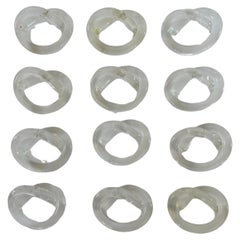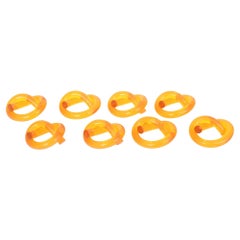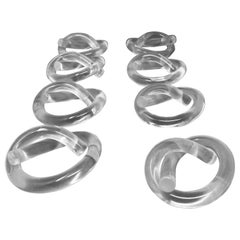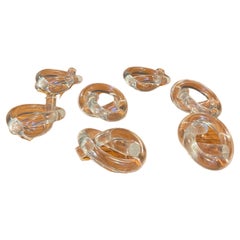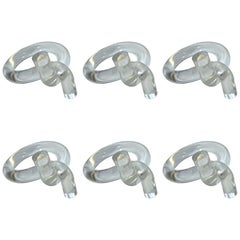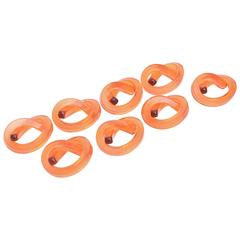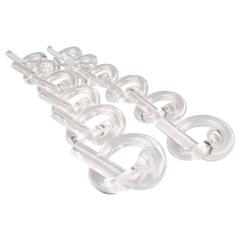Dorothy Thorpe Napkin Rings
Mid-20th Century American Mid-Century Modern Tableware
Acrylic, Lucite
Vintage 1970s American Modern Tableware
Lucite
Vintage 1970s American Mid-Century Modern Serving Pieces
Lucite
Late 20th Century American Mid-Century Modern More Dining and Entertaining
Lucite
Vintage 1960s Danish Scandinavian Modern More Dining and Entertaining
Lucite
Recent Sales
Vintage 1970s American Modern Tableware
Lucite
Vintage 1970s North American Tableware
Lucite
Vintage 1970s American Modern Tableware
Lucite
Vintage 1960s American Mid-Century Modern Serving Pieces
Lucite
Vintage 1970s American Organic Modern Tableware
Lucite
Mid-20th Century American Mid-Century Modern Tableware
Lucite
Vintage 1960s North American Collectible Jewelry
Lucite
Vintage 1970s American Mid-Century Modern Tableware
Lucite
Vintage 1970s American Modern Tableware
Lucite
Vintage 1970s American Modern Tableware
Lucite
Vintage 1970s American Mid-Century Modern Tableware
Lucite
Late 20th Century American Mid-Century Modern Tableware
Lucite
Vintage 1960s American Mid-Century Modern Tableware
Lucite
Vintage 1960s American Mid-Century Modern Tableware
Lucite
Vintage 1960s American Mid-Century Modern Tableware
Lucite
Vintage 1970s American Mid-Century Modern Tableware
Lucite
Late 20th Century Mid-Century Modern More Dining and Entertaining
Lucite
20th Century Mid-Century Modern Tableware
Lucite, Acrylic
Vintage 1950s American Tableware
Lucite
People Also Browsed
2010s Organic Modern Dining Room Tables
Travertine
Mid-20th Century American Mid-Century Modern Barware
Metal
Vintage 1980s North American Post-Modern Tableware
Lucite
Dorothy Thorpe Napkin Rings For Sale on 1stDibs
How Much are Dorothy Thorpe Napkin Rings?
Dorothy Thorpe for sale on 1stDibs
Dorothy Thorpe glassware was a chic staple of every mid-century modern wet bar, particularly her festive Roly Poly silver-banded tumblers. Although not as widely known as such contemporaries as Eva Zeisel and Edith Heath, Thorpe was one of a group of creative and entrepreneurial women whose designs captured the imagination of the postwar homeowner with her modern and cheery works.
Thorpe was born in Salt Lake City in 1901 and settled in Los Angeles as a young woman. She began creating her signature glassware using the trade name Dorothy Thorpe Originals in the 1930s. Thorpe was a designer, not a glassblower. To create her shimmering wares, she purchased glass blanks from a variety of manufacturers and subjected them to various techniques, including sandblasting, etching and silver overlay.
Initially Art Deco in style, the pieces were signed with a large T and smaller D. Thorpe also worked in ceramics and, in the 1940s, with Lucite, producing a line of household items, such as magazine racks, sculptural lamps, candlesticks and umbrella stands.
After World War II, Thorpe was inspired by a new interest in the flowers and animals of the South Pacific and began incorporating tropical floral motifs into her work. She traveled to Hawaii and studied local irises, roses, azaleas, narcissus and eucalyptus. The decorative patterns based on these studies were created primarily by sandblasting, which makes a glass surface appear frosted.
From the 1930s through the ’50s, Thorpe’s designs won her many fans among the members of café society, including Princess Grace of Monaco and the Shah of Iran. They were also widely imitated. Vintage tumblers that bear a silver stripe around the rim but lack the “DT” signature on the bottom are not Thorpe originals.
In the 1950s, Thorpe created the glassware line Atomic Splash, which featured the energetic geometric patterns that were so popular at the time. Atomic Splash patterned drinking glasses and serving dishes bore a silver overlay that evoked an explosion.
Thorpe also designed a line of ceramic tableware decorated with a wreath of spring flowers in collaboration with Crown Lynn Pottery, in New Zealand, and, in the mid-’60s, created coffee sets for the Santa Barbara and Monterey companies. Among her own ceramics products were lines glazed in the eye-catching shades of Orange Persimmon and Blue Periwinkle.
Find vintage Dorothy Thorpe glasses and tableware for sale on 1stDibs.
Materials: Lucite Furniture
Antique, new and vintage Lucite furniture has been on design editors’ radars for several seasons now, but thanks to a renewed interest in Lucite coffee tables, chairs and other pieces from the late 1960s and ’70s, the trend has reached fever pitch.
“I think there’s a freshness and cleanness to it,” says Fawn Galli, an interior designer based in New York. Not only is Lucite, or transparent plastic, practical, since it can work in nearly any environment, it’s incredibly stylish.
Some of the most acclaimed furniture designers share the same love for Lucite as an effective and practical material for use in any interior.
“I think there’s something really nice about the simplicity of anything Lucite or acrylic — it feels lightweight,” says Tamara Eaton, whose eponymous firm deftly balances traditional and modern designs. Even in the most historical setting, “you can still introduce some Lucite or something kind of lightweight and not have it feel like a distinct interjection, but a playful one that’s more about the shape,” she says.
For the living room in a mid-century modern townhouse in Park Slope, Brooklyn, Eaton chose a pair of box-shaped Lucite tables with copper handles from Jamie Dietrich. “We didn’t want anything to be too heavy, and that area was a place where [the family] would sometimes move those tables so the kids could play,” she says. The tables doubled as snack trays since the kitchen is nearby. “They have this transportable feel to them that I think was really fun.”
Browse a range of antique, new and vintage Lucite side tables, table lamps and other furniture now on 1stDibs.
Finding the Right Serveware, Ceramics, Silver And Glass for You
Your dining room table is a place where stories are shared and personalities shine — why not treat yourself and your guests to the finest antique and vintage glass, silver, ceramics and serveware for your meals?
Just like the people who sit around your table, your serveware has its own stories and will help you create new memories with your friends and loved ones. From ceramic pottery to glass vases, set your table with serving pieces that add even more personality, color and texture to your dining experience.
Invite serveware from around the world to join your table settings. For special occasions, dress up your plates with a striking Imari charger from 19th-century Japan or incorporate Richard Ginori’s Italian porcelain plates into your dining experience. Celebrate the English ritual of afternoon tea with a Japanese tea set and an antique Victorian kettle. No matter how big or small your dining area is, there is room for the stories of many cultures and varied histories, and there are plenty of ways to add pizzazz to your meals.
Add different textures and colors to your table with dinner plates and pitchers of ceramic and silver or a porcelain lidded tureen, a serving dish with side handles that is often used for soups. Although porcelain and ceramic are both made in a kiln, porcelain is made with more refined clay and is more durable than ceramic because it is denser. The latter is ideal for statement pieces — your tall mid-century modern ceramic vase is a guaranteed conversation starter. And while your earthenware or stoneware is maybe better suited to everyday lunches as opposed to the fine bone china you’ve reserved for a holiday meal, handcrafted studio pottery coffee mugs can still be a rich expression of your personal style.
“My motto is ‘Have fun with it,’” says author and celebrated hostess Stephanie Booth Shafran. “It’s yin and yang, high and low, Crate & Barrel with Christofle silver. I like to mix it up — sometimes in the dining room, sometimes on the kitchen banquette, sometimes in the loggia. It transports your guests and makes them feel more comfortable and relaxed.”
Introduce elegance at supper with silver, such as a platter from celebrated Massachusetts silversmith manufacturer Reed and Barton or a regal copper-finish flatware set designed by International Silver Company, another New England company that was incorporated in Meriden, Connecticut, in 1898. By then, Meriden had already earned the nickname “Silver City” for its position as a major hub of silver manufacturing.
At the bar, try a vintage wine cooler to keep bottles cool before serving or an Art Deco decanter and whiskey set for after-dinner drinks — there are many possibilities and no wrong answers for tableware, barware and serveware. Explore an expansive collection of antique and vintage glass, ceramics, silver and serveware today on 1stDibs.
